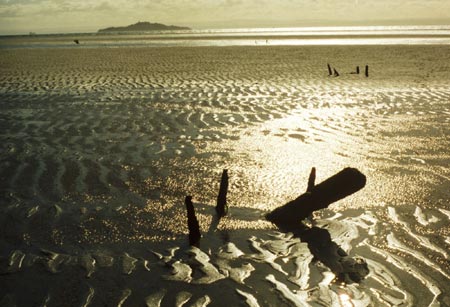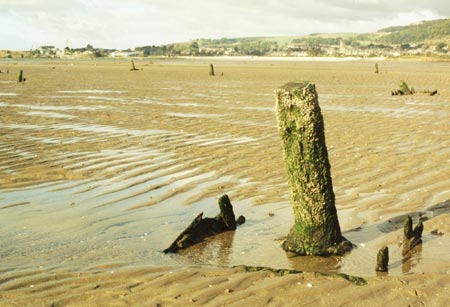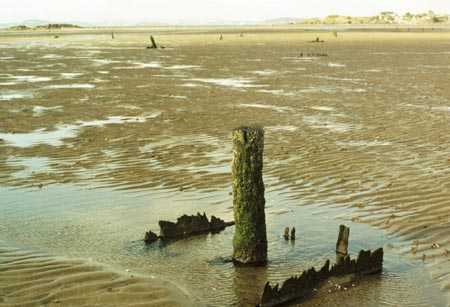Forth Anti Glider Landing Poles at Burntisland and Aberlady Bay
At Burntisland the remains of Second World War anti glider landing poles are sufficiently well preserved to present a danger to dinghies and shoal draft yachts tempted to take a short cut across the sands on a high tide. Straight double rows of staggered poles run along the beach and at right angles to it dividing the foreshore into rectangles. They are sufficiently numerous to give a good impression of what wartime Forth beach defences looked like. Vestiges of these obstacles are found elsewhere on the East Coast such as the Eden Estuary but here I concentrate on Burntisland and Aberlady Bay .
The allied fear of airborne assault stemmed from the May 1940 coup de main (blitzkrieg) attack of German glider borne troops capturing the seemingly impregnable Belgian Fort of Eben Emael http://www.historylearningsite.co.uk/capture_of_fort_eben.htm on the Albert Canal. At Burntisland as at Aberlady Bay on the South shore of the Forth a wide expanse of hard sand would have made an excellent glider landing ground; Aberlady especially, having a gentle up grade into the prevailing wind.
Clearly for comprehensive defence of the Forth it was necessary to counter this threat and so poles of tree trunk dimensions were set in the sand to damage aircraft attempting to land. Both allied and axis forces deployed anti landing poles which had become known on both sides as “Rommel’s Asparagus” (Rommelspargel). Unlike the poles erected on dry land, those used on these mobile sands were set in concrete footing. Around many of the poles at Burntisland one can still see the shuttering box with a timber at each corner used to retain the concrete.
At Aberlady only a scatter of the poles remain and from the surface there is no sign that concrete was used. Most appear to have been cut off shorter than those over at Burntisland but the most likely explanation of this is local deposition burying the poles deeper. I did some digging to confirm that the poles, like those at Burntisland, had been set in concrete. This proved to be the case and was an informative exercise. Digging was difficult, the waterlogged sand pouring back into the hole, demonstrating a difficulty that would have been encountered by the original constructors. Clearly the shuttering box served the dual function of keeping sand and water out of the hole until concrete could be poured.
Sixty plus years of sand movement at Aberlady has substantially completed the task of pole removal. One supposes the missing poles have fallen over and are buried. Samples of the concrete prove a strong mix was used, with imported gravel and has withstood the effects of immersion well.
A walk over the Aberlady sands begs the question whether the wooden wrecks further down the shore were placed as additional anti air landing obstacles. The large one to the North appears especially well sited for this purpose.
After the War one area of the Burntisland poles was cut off at knee height and others at waist height. It looks as if this was done to salvage the timber and perhaps stop the poles being used to support nets to catch salmon and sea trout rather than to remove a hazard to navigation. Here, as elsewhere in Scotland , poles on a beach suggest stake nets, leading to confusion regarding their original purpose. Legally a type of “fixed engine” this method of fishing is still permitted in Scotland although it is regulated. However, the uniformity of the construction method, generosity of the concrete and diameter of the poles used all point to a Government job, leaving no doubt as to their original purpose.
A look at a map reveals the strategic importance of anti air landing defences on these sands. Five miles from Aberlady Bay is East Fortune Airfield. Capture of this via a landing at Aberlady would at the least have lead to the destruction of the airfield and perhaps the reinforcement of the initial assault troops by air. Airfields themselves were defended against offensive landings, being ringed by pillboxes with a field of fire over the runways. On the Forth a good example of this still exists at Crail airfield (HMS Jackdaw) where the slits of the seaward pillboxes look inland, rather than out to sea, puzzling some visitors. Burntisland sands are very close to a substantial impounded dock and not so far from the prime targets of the Forth railway bridge and Rosyth Naval base.
In France the beaches have long since been cleared and poles in fields removed for agriculture so it is likely those at Burntisland represent the best example of this type of defence remaining in Europe . The humble, once common place, anti landing pole has become so unusual that the vast majority of the holidaymakers enjoying the pleasantly sun soaked south facing Burntisland sands have absolutely no idea of their purpose. They echo the Admiralty target barge at Blackness, once so common that nobody would give it a second glance, now it is a 19 th century derelict of considerable interest.
While the military glider is history, the anti air landing pole is not as the various anti helicopter variants used by the North in Vietnam demonstrated. It remains a weapon of the armed insurgent still used with effect.
For shore side access to the Burntisland sands there is roadside parking on the A 921 to the East of the town. The shore is reached via a pedestrian tunnel under the railway. Alternatively one can use the car park at Pettycur harbour. For directions to Aberlady see The Aberlady Bay X-Craft Miniature Submarines.
Paul Shave
Yacht Blue Spindrift
January 2006







